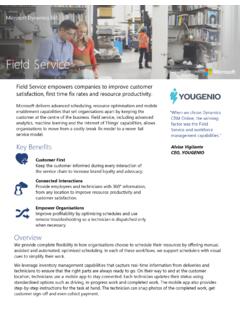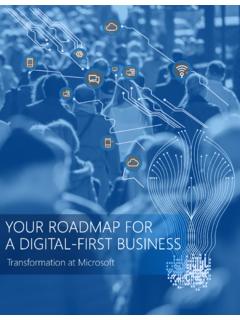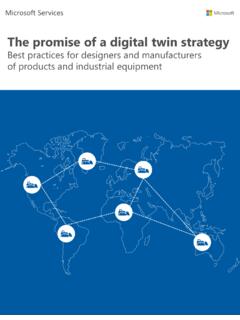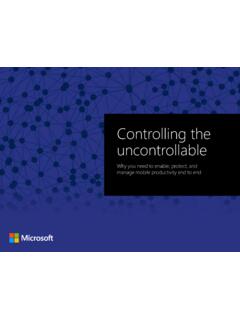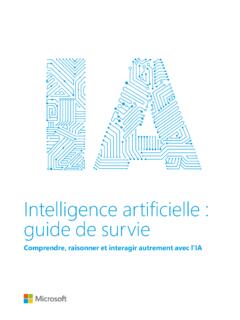Transcription of CIO’s guide to Azure Active Directory - …
1 CIO's guide to Azure Active Directory Identity and Access Management as a Service boosts organizational effectiveness CIO'S guide TO Azure Active Directory . Executive summary Being an effective Chief Information Officer (CIO) in a modern, global business world is not simply about managing an efficient department that delivers on its service level agreement (SLA); increasingly, your function is to be the driver and enabler of current and future revenue streams. You must be a proactive provider, who can anticipate the company's long-term direction. You also work as a peer with your senior leadership colleagues to open up new avenues to growth and make a quantifiable contribution to the organization's mission. Microsoft Azure Active Directory , the Identity and Access Management as a Service (IDaaS) component of the Enterprise Mobility and Security Suite, accelerates the rate at which you can achieve this ambition.
2 It gives secure and productive access to the applications your users need to do their jobs, both now and in the future. Azure Active Directory extends your on-premises directories into the cloud, providing a truly global identity and access management solution that delivers effective, secure and modern IT services. It releases you from the constraints of on-premises Directory services to provide global reach and secure user access to vital data. It also integrates line-of-business apps into multidevice, multiplatform environments that deliver fully realized IT agility, while controlling costs and enforcing security. This guide explains how to make Azure Active Directory a central part of your IT. strategy. You will review the priorities of your CIO peers and consider how they plan, or have already have embarked on, this innovative strategic direction.
3 Having read this white paper, you will appreciate how updating and modernizing your identity and access management services better prepares your organization for the next wave of IT. modernization. This proactive approach ensures that your organization remains at the forefront of technology and maximizes the flexibility and cost reduction benefits of cloud-enabled identity and access management. 2. CIO'S guide TO Azure Active Directory . Identifying the challenges that CIOs face today Information Technology (IT) is a major contributor to the rate of change within the world. IT not only enables change in almost any endeavor to take place more quickly, There is nothing but also accelerates the development of the very technologies which, in turn, generate permanent further change. Consequently, the role of CIO within most organizations has been except change.
4 Transformed, from that of primarily providing a supporting service, to being an integral Heraclitus (c. 535-475 BC). and essential part of how a company delivers value to its customers. Forrester recently completed a survey1 of 1,087 business decision makers and influ- encers around the world to identify the top technology management organizational priorities for enterprise customers who are dealing with rapid rates of change. Figure 1 shows the top five findings from this study, which all point to the need to respond effectively to this challenge. Technology Management Priorities Base: Security Technology Purchase Influencers Increase the use of innovative technologies 45%. Cut overall IT costs 41%. Improve IT project delivery 40%. Improve management of partners and suppliers 39%.
5 Acquire or develop new IT skills 39%. Figure 1: Top technology management priorities for CIOs Increase the use of innovative technologies In today's business world, a CIO needs to be so much more than a technologist. You must have a keen appreciation of how to use technology to empower your business and be able to add value incrementally in all areas of operation. You have to respond to customer needs and show return on investment within weeks, not years. You appreciate that securing the business is a factor in all areas of IT operations and you will need additional security capabilities that are as agile as your new services. Cut overall IT costs Today's ever-growing IT expenditure is driven by a range of factors that increase risk and keep costs high. These factors include: The rising cost and availability of specific expertise.
6 The number of discrete services you are developing and managing. The cost of securing these separate systems. 1. Forrester Data Business Technographics global Priorities & Journey Survey 2016. 3. CIO'S guide TO Azure Active Directory . The cost of compliance associated with these services. The manual processes associated with outdated approaches. To address these challenges, you need to investigate emerging cloud solutions, architectures and IT patterns that give you back control and reduce costs, while still generating growth and protecting the company. Improve IT project delivery Today, you no longer have the luxury of taking the time to stop and plan multiyear proj- ects to evolve your IT infrastructure. Technology that you may have identified as being of value at the scoping phase might have been completely superseded by the time you arrive at the implementation phase.
7 Increasingly, you need greater IT agility, where the approach is to focus on incremental steps, gain quick wins and reap business benefit . then repeat until you have evolved your IT architecture to a modern, configurable, low maintenance, secure, and auditable system. Improve management of partners and suppliers Modern companies thrive by successfully utilizing a partner ecosystem and supply chain that helps the company to expand quickly and address new business opportunities without having to recruit new employees. Secure collaboration with your organization's partners and suppliers is key to running a successful and productive business, while at the same time reducing risk. The rapid changes in your partner and suppliers' business- es now require a more flexible and fluid way to maintain secure access to the resources that encourage effective collaboration.
8 Acquire or develop new IT skills Your company workforce is changing rapidly in line with global trends. More than ever, IT departments need to respond instantly to customer demands. End users in your company expect you to offer services that are up-to-date and have similar usage patterns to the modern mobile applications with which they have become very familiar and take for granted. Within your department, it is becoming increasingly harder to find talented staff who are interested in working on what is perceived as legacy infra- structure. Aim The aim of this paper is to explain how Microsoft Azure Active Directory can address the top five CIO priorities identified in the recent Forrester study. This paper also shows how Azure Active Directory (AD) can help with other challenges that affect modern IT.
9 Environments. Answering CIO challenges with Azure Active Directory Azure AD is Microsoft's Identity and Access Management as a Service (IDaaS) offering for organizations of all sizes. Companies without on-premises Active Directory can use it as their main identity and access management resource; those with Active Directory or other directories already deployed can connect their current infrastructure and 4. CIO'S guide TO Azure Active Directory . synchronize identity attributes into the cloud. Any app that you deploy can then con- nect to your instance of Azure AD for secure single sign-on and use that information to boost employee productivity, enhance partner working, build customer relations, and maximize sales. Figure 2 shows the relative importance of being able to stream identity information throughout an organization.
10 More than half of CIOs reported that this ability was a high priority for adoption. Streamlining Employee Identity and Access Management to Applications, Systems, and Data Across the Organization Sample Size = 2,320. Not on our agenda / Low Priority (1, 2) 13%. Moderate Priority (3) 30%. High Priority (4,5) 56%. Don't Know (98) 1%. Figure 2: Priority levels for streaming employee identities across organizations Increase the use of innovative technology The proliferation of Software as a Service (SaaS) applications of all types offers organi- zations a range of innovative new technologies that can enhance productivity. However, this growth also brings the challenge of easily providing these new technologies to your end users in ways with which they will most benefit. Ninety percent of CIOs report that upgrading or simplifying the user experience is a key concern; usefully, Azure AD.
